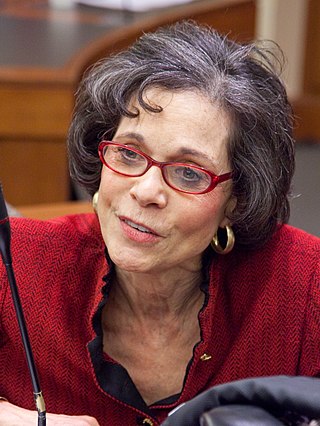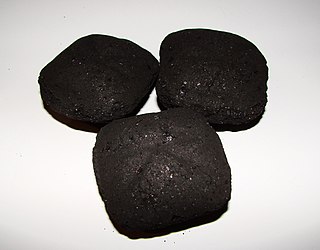
Pollution is the introduction of contaminants into the natural environment that cause adverse change. Pollution can take the form of any substance or energy. Pollutants, the components of pollution, can be either foreign substances/energies or naturally occurring contaminants.

Smog, or smoke fog, is a type of intense air pollution. The word "smog" was coined in the early 20th century, and is a portmanteau of the words smoke and fog to refer to smoky fog due to its opacity, and odor. The word was then intended to refer to what was sometimes known as pea soup fog, a familiar and serious problem in London from the 19th century to the mid-20th century, where it was commonly known as a London particular or London fog. This kind of visible air pollution is composed of nitrogen oxides, sulfur oxide, ozone, smoke and other particulates. Man-made smog is derived from coal combustion emissions, vehicular emissions, industrial emissions, forest and agricultural fires and photochemical reactions of these emissions.

Smoke is a suspension of airborne particulates and gases emitted when a material undergoes combustion or pyrolysis, together with the quantity of air that is entrained or otherwise mixed into the mass. It is commonly an unwanted by-product of fires, but may also be used for pest control (fumigation), communication, defensive and offensive capabilities in the military, cooking, or smoking. It is used in rituals where incense, sage, or resin is burned to produce a smell for spiritual or magical purposes. It can also be a flavoring agent and preservative.

The Clean Air Act 1956 was an Act of the Parliament of the United Kingdom enacted principally in response to London's Great Smog of 1952. It was sponsored by the Ministry of Housing and Local Government in England and the Department of Health for Scotland, and was in effect until 1993.

Fumifugium, or, The inconveniencie of the aer and smoak of London dissipated together with some remedies humbly proposed by J.E. esq. to His Sacred Majestie, and to the Parliament now assembled is a pamphlet published in London, 1661, by John Evelyn. It is one of the earliest known works on air pollution and is still considered a significant contribution to the literature on the subject over three and half centuries after its publication. The letter was specifically addressed to King Charles II of England and discussed problems with the capital's air pollution dating back to medieval times. Evelyn refers to Greek philosophers, who once believed that air was the principle of the earth and primary substance of the soul up until the time that air pollution began to cause ill health.

Devra Lee Davis is an American epidemiologist, toxicologist, and author of three books about environmental hazards. She was founding director of the Center for Environmental Oncology at the University of Pittsburgh Cancer Institute, and is a former professor of epidemiology at University of Pittsburgh Graduate School of Public Health. She has served on several governmental and non-governmental organizations, conducting research and advocacy into effects of pesticides, asbestos, and wireless radiation on human health, especially cancers.

Air pollution is the contamination of air due to the presence of substances called pollutants in the atmosphere that are harmful to the health of humans and other living beings, or cause damage to the climate or to materials. It is also the contamination of the indoor or outdoor environment either by chemical, physical, or biological agents that alters the natural features of the atmosphere. There are many different types of air pollutants, such as gases, particulates, and biological molecules. Air pollution can cause diseases, allergies, and even death to humans; it can also cause harm to other living organisms such as animals and crops, and may damage the natural environment or built environment. Air pollution can be caused by both human activities and natural phenomena.

Smokeless fuel is a type of solid fuel which either does not emit visible smoke or emits minimal amounts during combustion. These types of fuel find use where the use of fuels which produce smoke, such as coal and unseasoned or wet wood, is prohibited.

Sentinel species are organisms, often animals, used to detect risks to humans by providing advance warning of a danger. The terms primarily apply in the context of environmental hazards rather than those from other sources. Some animals can act as sentinels because they may be more susceptible or have greater exposure to a particular hazard than humans in the same environment. People have long observed animals for signs of impending hazards or evidence of environmental threats. Plants and other living organisms have also been used for these purposes.

Environmental Protection UK is a UK environmental non-governmental organisation (NGO) working to improve the quality of the local environment - specialising in the subjects of air quality, noise management and land quality. It was formerly known as the National Society for Clean Air and Environmental Protection (NSCA), changing its name 2007, to reflect ongoing work in fields beyond air quality.
Air pollution is the introduction of chemicals, particulate matter, or biological materials into the atmosphere, causing harm or discomfort to humans or other living organisms, or damaging ecosystems. Air pollution can cause health problems including, but not limited to, infections, behavioral changes, cancer, organ failure, and premature death. These health effects are not equally distributed across the U.S. population; there are demographic disparities by race, ethnicity, socioeconomic status, and education. Air pollution can derive from natural sources, or anthropogenic sources. Anthropogenic air pollution has affected the United States since the beginning of the Industrial Revolution.
The 1948 Donora smog killed 20 people and caused respiratory problems for 6,000 of the 14,000 people living in Donora, Pennsylvania, a mill town on the Monongahela River 24 miles (39 km) southeast of Pittsburgh. The event is commemorated by the Donora Smog Museum.

Pea soup fog is a very thick and often yellowish, greenish or blackish fog caused by air pollution that contains soot particulates and the poisonous gas sulphur dioxide. This very thick smog occurs in cities and is derived from the smoke given off by the burning of soft coal for home heating and in industrial processes. Smog of this intensity is often lethal to vulnerable people such as the elderly, the very young (infants) and those with respiratory problems. The result of these phenomena was commonly known as a London particular or London fog; in a reversal of the idiom, "London particular" became the name for a thick pea and ham soup.

Air pollution in the United Kingdom has long been considered a significant health issue, and it causes numerous other environmental problems such as damage to buildings, forests, and crops. Many areas, including major cities like London, are found to be significantly and regularly above legal and recommended pollution levels. Air pollution in the UK is a major cause of diseases such as asthma, lung disease, stroke, cancer, and heart disease, and is estimated to cause forty thousand premature deaths each year, which is about 8.3% of deaths, while costing around £40 billion each year.

Particulates or atmospheric particulate matter are microscopic particles of solid or liquid matter suspended in the air. The term aerosol commonly refers to the particulate/air mixture, as opposed to the particulate matter alone. Sources of particulate matter can be natural or anthropogenic. They have impacts on climate and precipitation that adversely affect human health, in ways additional to direct inhalation.

Air pollution measurement is the process of collecting and measuring the components of air pollution, notably gases and particulates. The earliest devices used to measure pollution include rain gauges, Ringelmann charts for measuring smoke, and simple soot and dust collectors known as deposit gauges. Modern air pollution measurement is largely automated and carried out using many different devices and techniques. These range from simple absorbent test tubes known as diffusion tubes through to highly sophisticated chemical and physical sensors that give almost real-time pollution measurements, which are used to generate air quality indexes.

The 1966 New York City smog was a major air-pollution episode and environmental disaster, coinciding with that year's Thanksgiving holiday weekend. Smog covered the city and its surrounding area from November 23 to 26, filling the city's air with damaging levels of several toxic pollutants. It was the third major smog in New York City, following events of similar scale in 1953 and 1963.
The 1962 London smog was a severe smog episode that affected London, England, in December 1962. It occurred ten years after the Great Smog of London, in which serious air pollution had killed as many as 12,000 people. While the 1952 smog had led to the passing of the 1956 Clean Air Act, which restricted the burning of domestic fuels in urban areas with the introduction of smokeless zones, fogs continued to be smoky in London for some years after the act as residents and operators were given time to convert from domestic fuels. The December 1962 smog is thought to have led to the deaths of up to 700 people.

A deposit gauge is a large, funnel-like scientific instrument used for capturing and measuring atmospheric particulates, notably soot, carried in air pollution and "deposited" back down to ground.
Peter Brimblecombe is an Australian-born, British atmospheric chemist, currently emeritus professor of atmospheric chemistry at the University of East Anglia and National Sun Yat-sen University in Taiwan. In a five-decade research career, he has written or co-authored seven books and around 350 peer-reviewed papers on air pollution and its effects on human health and the environment, but is probably best known as the author of The Big Smoke, which has been described as a definitive history of air pollution.




















